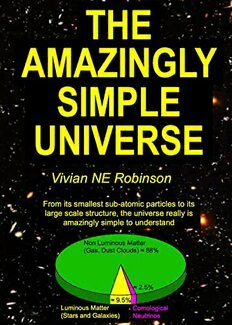
The Amazingly Simple Universe PDF
02022·2.234 MB·English
Most books are stored in the elastic cloud where traffic is expensive. For this reason, we have a limit on daily download.
Preview The Amazingly Simple Universe
Description:
The Amazingly Simple Universe is a description of the universe from its smallest sub-atomic particles to its large scale structure. It goes beyond standard models to a totally new way of looking at all levels of the universe. The author was the first person to publish a paper pointing out the physics of Einstein's gravity. He presented it in such a manner that some good high school matriculants could easily calculate Einstein's gravitational fields strengths. He uses the same approach for the rest of the universe. It is described in three space dimensions and time, using only known and observed particles and physical principles.It is a physical description of the universe's simplicity. The only equation used is E = mc^2, as it describes the amazingly simple relationship between energy, E and mass m. There are only five stable particles in the universe, photons, electrons, protons, neutrons and neutrinos. The structure of each of them is shown as it indicates how their structure gives them their properties. Those properties include their mass, electric charge, spin, and the special relative corrections, among others.That is followed by a description of how Einstein's special relativity corrections are responsible for the elementary particles detected in particle accelerators. It is simple to understand.The Amazingly Simple Universe shows how neutral neutrons bind positive protons together to form nuclei. It makes nuclear physics an easy topic to understand.A brief description of some of the properties of electrons in atoms gives all the mass of the universe. That gives all the mass of the universe.With mass comes gravity. The Amazingly Simple Universe indicates the physics upon which Einstein's gravity was based. It also shows the simple physics errors made by those who believe in black holes. Einstein did not believe in them. The physics description given is such that some good high school matriculants could easily point out the physical errors made by those who believe in them. That is followed by a simple description of how the properties of protons and neutrons generate gravity and why all mass responds the same to gravity.Gravity holds stars in galaxies. The must rotate to prevent the stars collapsing to the centre. The Amazingly Simple Universe shows why galaxy rotation is as expected. There is no need for dark matter. Its concept came from cosmologists' use of Kepler's laws of planetary motion around the sun. Why they don't apply to galaxies is shown. Other galaxy properties are presented.Cosmologists did not understand Einstein's mathematics and misinterpreted it. His gravity theory predicts that gravity is weaker than Newton's inverse square law. When gravity is weaker than inverse square law, an infinite steady state universe will not collapse. It indicates how the measurement that predicts an accelerating universe are the natural results for an infinite steady state universe. It applies for any density universe. The universe is not even expanding, let alone expanding at an accelerating rate.This is a simplified physical description only. It is intended for the curious reader who wants to know how the universe functions in an easy and simple to understand manner. Greater explanation is given in "How E = mc^2 Shapes the Universe". A detailed physical description backed by the necessary mathematics is given in "How to Build a Universe".
See more
The list of books you might like
Most books are stored in the elastic cloud where traffic is expensive. For this reason, we have a limit on daily download.
